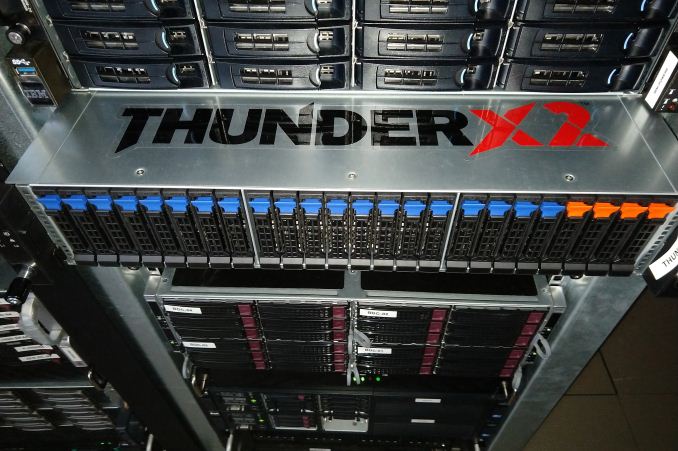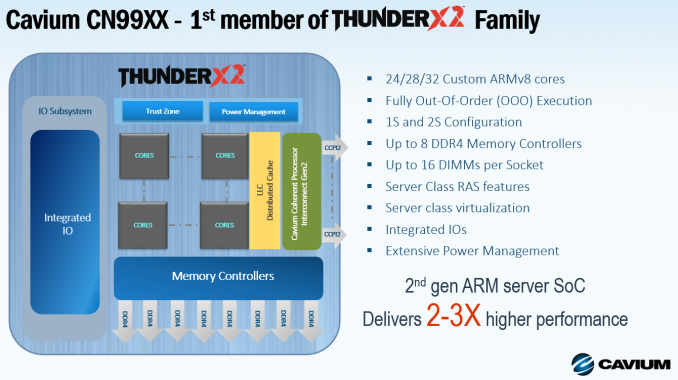Assessing Cavium's ThunderX2: The Arm Server Dream Realized At Last
by Johan De Gelas on May 23, 2018 9:00 AM EST- Posted in
- CPUs
- Arm
- Enterprise
- SoCs
- Enterprise CPUs
- ARMv8
- Cavium
- ThunderX
- ThunderX2

A little less than 2 years ago, we investigated the first Arm server SoC that had a chance to compete with midrange Xeon E5s: the Cavium ThunderX. The SoC showed promise, however the low single-threaded performance and some power management issues relegated the 48-core SoC to more niche markets such as CDN and Web caching. In the end, Cavium's first server SoC was not a real threat to Intel's Xeon.
But Cavium did not give up, and rightfully so: the server market is more attractive than ever. Intel's datacenter group is good for about 20 Billion USD (!) in revenue per year. And even better, profit margins are in 50% range. When you want to profits and cash flow, the server market far outpaces any other hardware market. So following the launch of the ThunderX, Cavium promised to bring out a second iteration: better power management, better single thread performance and even more cores (54).
The trick, of course, is actually getting to a point where you can take on the well-oiled machine that is Intel. Arm, Calxeda, Broadcom, AppliedMicro and many others have made many bold promises over the past 5 years that have never materialized, so there is a great deal of skepticism – and rightfully so – towards new Arm Server SoCs.
However, the new creation of underdog Cavium deserves the benefit of the doubt. Much has changed – much more than the name alone lets on – as Cavium has bought the "Vulcan" design from Avago. Vulcan is a rather ambitious CPU design which was originally designed by the Arm server SoC team of Broadcom, and as a result has a much different heritage than the original ThunderX. At the same time however, based on its experience from the ThunderX, Cavium was able to take what they've learned thus far and have introduced some microarchitectural improvements to the Vulcan design to improve its performance and power.
As a result, ThunderX2 is a much more "brainiac" core than the previous generation. While the ThunderX core had a very short pipeline and could hardly sustain 2 instructions per clock, the Vulcan core was designed to fetch 8 and execute up to 4 instructions per clock. It gets better: 4 simultaneous threads can be active (SMT4), ensuring that the wide back-end is busy most of the time. 32 of those cores at clockspeeds up to 2.5 GHz find a home in the new ThunderX2 SoC.
With up to 128 threads running and no less than eight DDR4 controllers, this CPU should be able to perform well in all server situations. In other words, while the ThunderX (1) was relegated to niche roles, the ThunderX2 is the first Arm server CPU that has a chance to break the server market open.











97 Comments
View All Comments
imaheadcase - Sunday, May 27, 2018 - link
Yah i tried that for a bit, it worked ok. But was not foolproof, it missed some stuff.repoman27 - Wednesday, May 23, 2018 - link
Just to provide a counter point, this article made my day. And that’s coming entirely from intellectual curiosity—I don’t plan on deploying any servers with these chips in the near future. I always enjoy Johan’s writing, and was really looking forward to seeing how ThunderX2 would stack up. Many people are convinced that ARM is really only suitable in low power / mobile scenarios, but this is the chip that may finally prove otherwise. That has significant ramifications for the entire industry (including the consumer space), especially when you consider that Cavium could put out a TSMC 10nm or even 7nm shrink of ThunderX2 before Intel can get off of 14nm.HStewart - Wednesday, May 23, 2018 - link
This does not proved that ARM is suitable in higher end space - look at the core specific speed - it extremely low compare to Intel and AMD server chips. Keep in mind it takes 128 total cores - running at 4SMT system. And what about other operations - what about Virtual Machine situation - where you have many virtual x86 machines on VMWare server,How about high end mathematical and vector logic?
It does seem like ARM can run more threads - but maybe Intel or AMD has never had the need to
I think this latest Core battle is silly - I think it really not the number of cores you have but combination of type and speed of cores along with number of cores.
Wilco1 - Wednesday, May 23, 2018 - link
It certainly does prove that Arm can do high end servers - the results clearly show IPC/GHz is very close on SPECINT. Base clock speeds are the same as the Intel cores, and that's the speed the server runs at when not idle. But there are more cores as you say, so who will win is obvious.Now imagine a next-gen 7nm version before Intel manages 10nm. Not a pretty picture, right?
HStewart - Wednesday, May 23, 2018 - link
Ok I have learn to agree to disagree with some peopleCan this server run the VMWare server
https://kb.vmware.com/s/article/1003882
The answer is no - just one example - many more,
On 10nm - it not number that matters - it technology behind it - Intel supposely has a i3 and Y based for CannonLake coming this year - probably more.
Wilco1 - Wednesday, May 23, 2018 - link
There are plenty of VMs for Arm, so virtualization is not an issue.10nm will be behind 7nm even if it ends up as originally promised and not using relaxed rules to become viable for volume production.
ZolaIII - Thursday, May 24, 2018 - link
When optimized for SIMD NEON extension things changed dramatically. All tho NEON isn't exactly the best SIMD never the less number's speak for them self.https://blog.cloudflare.com/neon-is-the-new-black/
Tho Centriq is a bit pricier, bit overly slower than this but main point is it whose built on comparable lithography to current Intel's 14nm. So you get cheaper hardware, which can be packaged tighter & will consume much less power while being compatible regarding the performance. Triple win situation (initial cost, cost of ownership and scaling) but it still isn't turn key one whit isn't crucial for big vendor server farms anyway.
name99 - Thursday, May 24, 2018 - link
ARM (and this particular chip) aren't trying to solve every problem in the world. They're trying to offer a better (cheaper) solution for a PARTICULAR subset of customers.If you think such customers don't exist, then why do you think Intel has such a wide range of Xeons, including eg all those Xeon Silvers that only turbo up to 3GHz? Or Xeon Gold's that max out at 2.8GHz?
lmcd - Thursday, May 24, 2018 - link
Second page: supports SR-IOV, which is important for KVM and Xen. If you're not aware, Xen and KVM are powerful virtualization solutions that cover the feature set of VMWare quite nicely.HStewart - Wednesday, May 23, 2018 - link
"I really think Anandtech needs to branch into different websites. Its very strange and unappealing to certain users to have business/consumer/random reviews/phone info all bunched together."I different in this - I don't think AnandTech should concentrate on just gaming in focus - this is rather old school - I am not sure about mobile phones in the mess of all this
But comparing ARM cpu's to Intel/AMD is interesting subject. It basically RISC vs CISC discussion - yes RISC can do operations quicker in some cases - but by definition of the architecture they are Reduce in what they do. Fox example it would take RISC a ton of instructions to executed a single AVX style operation.
This article is closest I have seen in comparing ARM vs x86 base machines - but even though I see some holes - it comes close - but having just be Linux based leaves out why people purchase such machine - I think Virtual Machine server is huge - but like everything else on the internet that is just an opinion